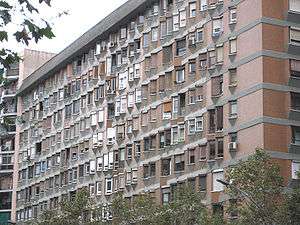La Sagrera

La Sagrera is a neighbourhood of Barcelona. It is bordered to the north with Sant Andreu del Palomar and to the east by the neighborhood of La Verneda; included by the south end is the zone named Navas, and to the west the Congress area.
The neighborhood of La Sagrera is integrated with the 9th district of the city of Barcelona, having officially been given the name of Sant Andreu (Saint Andrew), although never was part of the ancient municipality of Sant Andreu del Palomar, but to Sant Martí de Provençals; as a matter of fact, La Sagrera keeps closer links with Sant Andreu del Palomar than with the rest of neighborhoods nearby.
History
The origin of this name comes from the 11th century, when the farmers of Catalonia lived under the threats and the assaults of the noblity. The Abbot Oliba, seeing the need to protect to the farmers, imposed the creation of a space of 30 happen around the churches in which people and goods would be secured of any assault. In these spaces, the farmers built some small buildings called sagrers in Catalan, which used to save the harvests of the rector and the people of the hovering.
The first documented mention of La Sagrera is dated 998 and references to a group of houses, some with fortified towers, around the sagrera of the parish church of Sant Martí de Provençals. This scarce level of population lasted for a long time — by 1877 only some 48 houses could be found in the core of this settlement.
From the last third of the 19th century, however, the situation changed. The area became an industrial neighbourhood, with metallurgy and textile sectors predominating. Thus began the urbanisation of the district, with the name La Sagrera being retained only for the core zone of pre-existing housing.
Also around this time, specifically in 1877, dates the building of the steam tramway connecting the neighbourhood with Horta-Guinardó. The connection by tram of Horta with Barcelona by the year 1885 linked La Sagrera with Barcelona itself, a connection strengthened by the electrification of the line by 1901.
The industrialisation of the district saw the opening of the factory Hispano-Suiza in 1911 (renamed ENASA on 1946). This factory moved south to the Zona Franca by 1971. Currently there is an important group of apartment buildings, schools and a park named Pegaso.
In this process that lasts until the present time, the houses and the workshops have been replaced during the last twenty years of the 20th century to many blocks of apartments along both sides of the Avinguda Meridiana (Meridian Avenue). The name Meridiana indicates its North–South alignment.
At present, the transformation of the neighbourhood continues, particularly with Sagrera railway station, currently under constriction, which will link up the Barcelona Metro with local, regional and high-speed rail, with urban buses and with taxi services. The neighbourhood of the Sagrera is one of the best connected areas by means of underground transport, with rodalia R3 and R4, plus Metro lines L1, L5, L9 and L10, the last two still being under construction. Once complete, this will make La Sagrera into one of the major transport hubs for the Barcelona of the future.
Popular culture

Since the year 2003, La Sagrera has a "gegantera group". The so-called "gegants", that is "Giants", are a popular folk that amuse kids in all Catalonia and a gang of such giants is found in La Sagrera.
Entities
- Drac i Diables de la Sagrera
- Colla Gegantera de la Sagrera
- Esbart L'Estel de la Sagrera
- Associació Esportiva Districte IX Sant Andreu
- Centre de Documentació de la Sagrera
Also to see
- Archaeologic zone of the Sagrera
External links
- La Sagrera, a la web de l'Ajuntament
- Biblioteca La Sagrera-Marina Clotet
- Comissió de Festes de La Sagrera
- Colla Gegantera de La Sagrera
- Centre de Documentació de la Sagrera
- Drac i Diables de la Sagrera
Coordinates: 41°25′20.49″N 2°11′10.75″E / 41.4223583°N 2.1863194°E